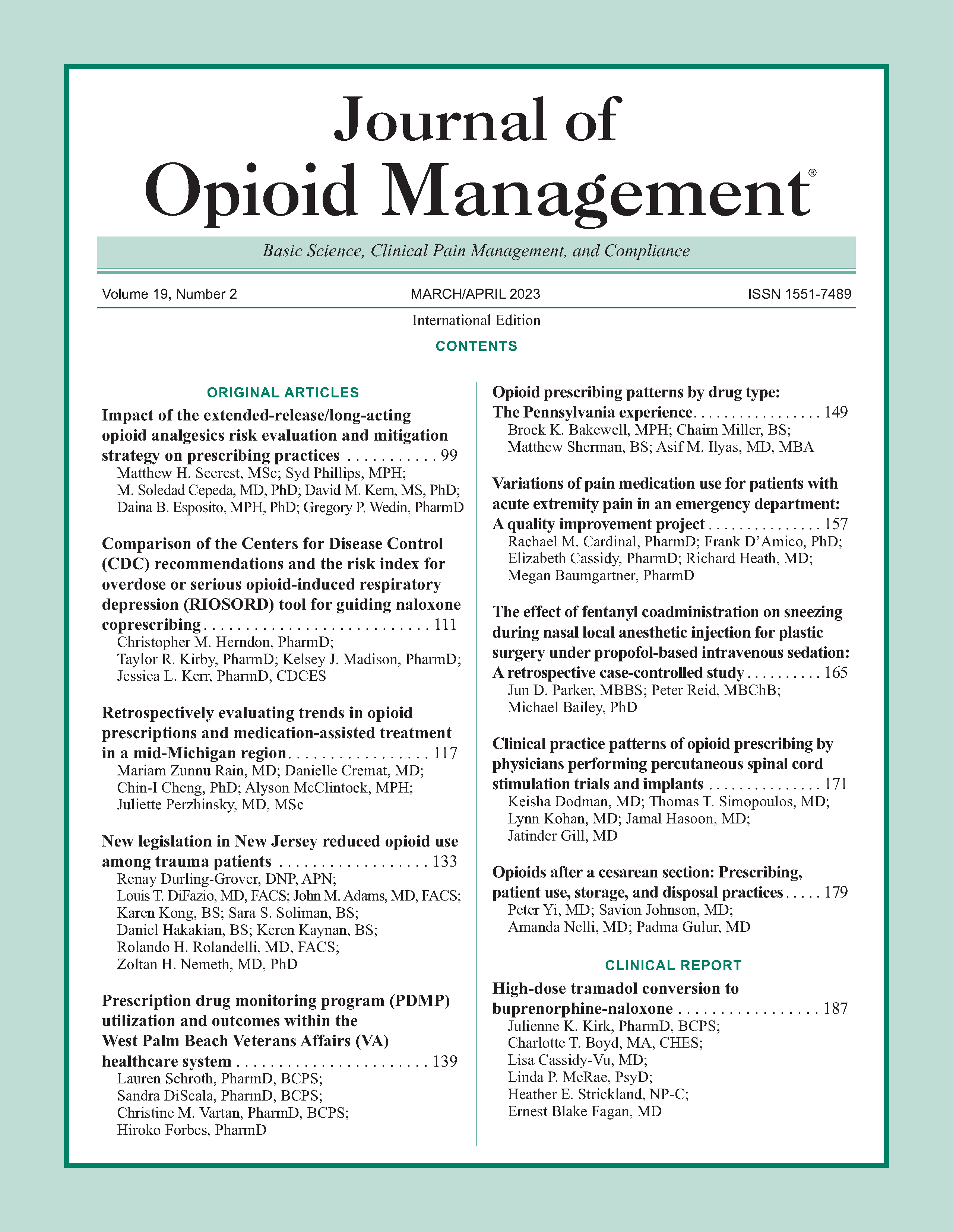Variations of pain medication use for patients with acute extremity pain in an emergency department: A quality improvement project
DOI:
https://doi.org/10.5055/jom.2023.0770Keywords:
opioids, nonopioids, acute extremity pain, emergency department, analgesicsAbstract
Objective: The opioid epidemic continues to take over 50,000 lives annually. At least 75 percent of patients present to an emergency department (ED) for pain. The objective of this study is to describe the characteristic(s) for receiving opioid, nonopioid, and combination analgesics in an ED for acute extremity pain.
Methods: A single-site, retrospective chart audit was conducted at a community-based teaching hospital. Patients ≥ 18 years old who were discharged from the ED with acute extremity pain and received at least one analgesic were included. Primary goal included determining characteristics associated with the prescribing of analgesics. Secondary goals included amount of pain score reduction, frequency of prescribing, and discharge prescription patterns among each group. Analyses consisted of univariate and multivariate general linear models analyses.
Results: There were 878 patients identified as having acute extremity pain between February and April 2019. A total of 335 patients met inclusion criteria and were separated into three groups: nonopioids (n = 200), opioids (n = 97), and combination analgesics (n = 38). The individual characteristics showing statistical differences (p < 0.05) between the groups were (1) an allergy to specific analgesics, (2) diastolic blood pressure > 90 mmHg, (3) heart rate > 100 bpm, (4) opioid use prior to ED admission, (5) prescriber level, and (6) discharge diagnosis. Multivariate analyses showed combination therapy (regardless of which two analgesics were administered) had a significant difference in mean pain score reduction compared to nonopioids (p < 0.05).
Conclusion: There are patient, prescriber, and environment-specific characteristics that are associated with analgesic selection in an ED. Combination therapy had the greatest reduction in pain regardless of the two medications received.
References
Downey LV, Zun LS: Pain management in the emergency department and its relationship to patient satisfaction. J Emerg Trauma Shock. 2010; 3(4): 326-330. DOI: 10.4103/0974-2700.70749.
Rudd R, Aleshire N, Zibbell J, et al.: Increases in drug and opioid overdose deaths—United States, 2000-2014. MMWR Morb Mortal Wkly Rep. 2016; 64(50): 1378-1382.
Pierik J, Ijzerman M, Gaakeer M, et al.: Pain management in the emergency chain: The use and effectiveness of pain management in patients with acute musculoskeletal pain. Pain Med. 2015; 16: 970-984. DOI: 10.1111/pme.12668.
Motov S, Strayer R, Hayes B, et al.: AAEM White Paper on acute pain management in the Emergency Department. AAEM. 2017. Available at https://www.aaem.org/resources/statements/position/white-paper-on-acute-pain-management-in-theemergency-department. Accessed September 9, 2020.
Pierik J, Berben S, Ijzerman M, et al.: A nurse-initiated pain protocol in the ED improves pain treatment in patients with acute musculoskeletal pain. Int Emerg Nurs. 2016; 27: 3-10. DOI: 10.1016/j.ienj.2016.02.001.
Seguin D: A nurse-initiated pain management advanced triage protocol for ED patients with an extremity injury at a level 1 trauma center. J Emerg Nurs. 2004; 30: 330-335. DOI: 10.1016/j.jen.2004.06.010.
Stawson D: Ibuprofen plus acetaminophen equals opioid plus acetaminophen for acute severe extremity pain. AAFP POEMs. 2018; 97(5): 348.
Chang AK, Bijur PE, Esses D, et al.: Effect of a single dose of oral opioid and nonopioid analgesics of acute extremity pain in the emergency department: A randomized clinical trial. JAMA. 2017; 318(17): 1661-1667. DOI: 10.1001/jama.2017.16190.
Friedman BW, Dym AA, Davitt M, et al.: Naproxen with cyclobenzaprine, oxycodone/acetaminophen, or placebo for treating acute low back pain: A randomized clinical trial. JAMA. 2015; 314(15): 1572-1580. DOI: 10.1001/jama.2015.13043.
Thomas SH, Mumma S, Satterwhite A, et al.: Variation between physicians and mid-level providers in opioid treatment for musculoskeletal pain in the emergency department. J Emerg Med. 2015; 49(4): 415-423. DOI: 10.1016/j.jemermed.2015.05.036.
Hoppe JA, Nelson LS, Perrone J, et al.: Opioid prescribing in a cross section of U.S. Emergency Departments: The Prescribing Opioids Safely in the Emergency Department (POSED) study consortium. Ann Emerg Med. 2015; 66(3): 253-259. DOI: 10.1016/j.annemergmed.2015.03.026.
Published
How to Cite
Issue
Section
License
Copyright 2005-2025, Weston Medical Publishing, LLC and Journal of Opioid Management. All Rights Reserved.











